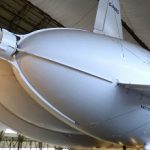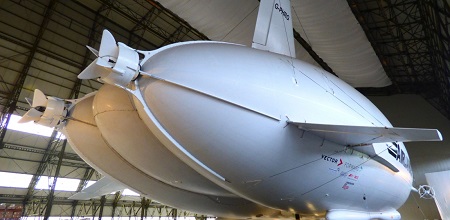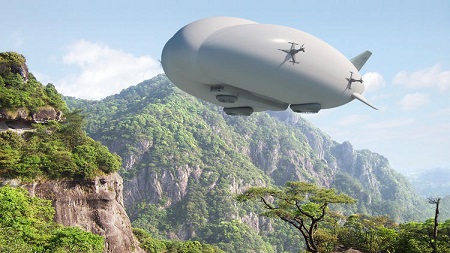 Source: Aviation International News – ainonline.com
Source: Aviation International News – ainonline.com
By Chris Pocock
The biggest disappointment of this Farnborough show must surely be the non-appearance of the Airlander 10.
The huge hybrid airship remains confined inside the hangar at Cardington from which it was due to emerge and fly last April. Its maker, Hybrid Air Vehicles (HAV, Hall 4 Stand 36) told AIN [Aviation International News] that no single problem had caused the delay. “We’ve erred on the side of caution, as we’re the first of a new type,” said a spokesman.
In fact, the Airlander 10 has flown before, but only once. This was in the U.S. in August 2012, when it was known as the Long Endurance Multi-Intelligence Vehicle (LEMV). HAV was subcontractor to Northrop Grumman for that U.S. Army program, which failed to deliver an unmanned ISR platform that could stay airborne for up to 21 days over Afghanistan. After it was cancelled, HAV bought the vehicle for a fraction of the total cost expended on the LEMV program, and shipped it to the UK. It has spent the past 30 months modifying and re-assembling the 300-foot-long, 150-foot-wide machine, which is powered by four vectoring 325-hp diesel engines.
A small company with limited resources, HAV has done well to get this far. Thanks to some generous key investors, plus government grants and an unprecedentedly successful crowdfunding campaign, the company has raised the £14 million it says is needed to test-fly and certify the Airlander, and begin to earn revenue—if not from sales, then at least from paid demonstrations.
Hybrid Air Vehicles’ Airlander 10 airship is shown in the company’s hangar at Cardington earlier this year after reassembly.
Source: ainonline.comAt least 100 flying hours are required before EASA will certify it, and HAV has been in dialogue over the airworthiness requirements for what is indeed a new class of air vehicle. One that gains up to 40 percent of lift aerodynamically from a multi-lobed lifting-body shape, compared with only 10 percent for a conventional cylindrical airship. One that can takeoff or land on unimproved surfaces, or even on water, and that can even do so vertically if required (at reduced payload).
Hybrids have other advantages over airships, notably in lifting potential and ease of handling—partly because they are, in fact, slightly heavier than air. HAV currently advertises a payload of 10 metric tons or 48 passengers for a production Airlander 10, with a manned endurance of five days flying at 80 knots. But since the prototype was built for a specific high-altitude ISR mission, it can only carry three metric tons or nine passengers.
Proponents claim that hybrids are a “game-changing” low-cost technology that is suited to many different missions. These include: airlifting cargo and people to remote regions that are expensive or impossible to reach by road or conventional aircraft and helicopters; border surveillance and communications relay; and eco-friendly passenger service between city centers. Users could include resource exploration companies, humanitarian aid agencies, government agencies, internet service providers, and high-value tourism operators.
HAV has only one serious competitor, albeit an unlikely one. The Lockheed Martin Skunk Works has been quietly pursuing large airship and hybrid technology for 25 years. Ten years ago, it made six test flights of a 120-foot long tri-lobe hybrid demonstrator. It has since designed vehicles with payloads of up to 50 metric tons, before settling on a 21-metric-ton payload hybrid aimed specifically at the remote-lift market.
At the Paris Air Show last year, the aerospace giant appointed an “independent reseller” named Hybrid Enterprises (HE) to market the Lockheed Martin Hybrid-1 (LMH-1). Earlier this year, LM constructed and showed off a full-scale mock-up of the 140-foot long flight deck, passenger and cargo compartment of the LMH-1 at Palmdale, California, within a setting that depicted it serving a remote open-pit mining site in Alaska.
But end-users, such as oil-and-gas exploration companies, are unwilling to sponsor development of the LMH-1, and LM won’t proceed without a firm order. HE has not yet attracted an existing airline or cargo operator, or aircraft leasing company. Instead, it has gained LM a letter of intent (LoI) from a British-led startup, Straightline Aviation. This company is staffed by veterans previously associated with Richard Branson and the Virgin Group’s ventures into lighter-than-air operations. Straightline has one rich backer, but will need more before it can firm up an LoI that LM said was worth some $480 million for the purchase of up to 12 hybrid airships. “We’re making good progress and expect to make an announcement in the autumn,” Straightline chief operating officer Mark Dorey told AIN last week.
Straightline also talked to HAV about the Airlander, but Dorey told AIN that it opted for the LMH-1 because it is more suited to the remote lift market. Meanwhile, HAV told AIN last week that “our launch customer is much more likely to be on the defense side, and we’ll progress discussion throughout Farnborough.”
Source: Aviation International News – ainonline.com


